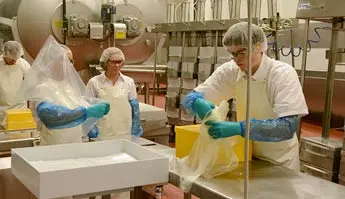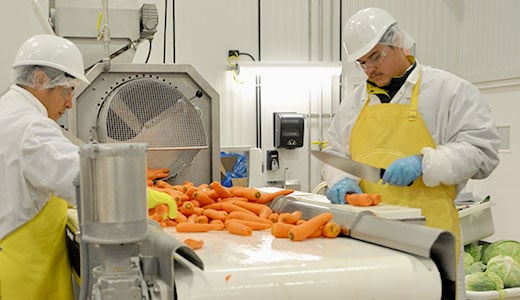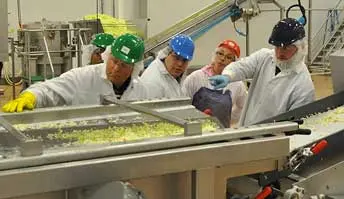Posted by Zosi Team

HACCP plans are the backbone of your food safety system. Built from the seven HACCP principles, these plans are mandated by regulatory bodies for the meat industry, the juice industry, and the seafood industry.
In order to ensure a safe food supply and protect your brand, you’ll need to comply with both regulations and customer expectations. In this blog, you’ll learn about the current status of USDA and FDA regulations for HACCP. If you are a member of your HACCP team we also recommend a HACCP certification for more formal training on the subject.
USDA/FSIS HACCP Regulations
USDA regulations for HACCP are twofold. First, an establishment must have a written HACCP plan that includes a documented Hazard Analysis and the identification of Critical Control Points as applicable to the products. For these CCPs, a facility must identify and document critical limits, monitoring, corrective actions, verification procedures and record keeping requirements. It is normally recommended every facility should have at least one CCP identified and more as needed dependent on the results of the hazard analysis and the types of products made.
Second, the USDA requires an establishment to operate per the requirements of their HACCP plan. If you fail to meet either of these provisions, your products may be considered adulterated.
In addition, USDA may deem a HACCP system inadequate if:
- The HACCP plan in operation does not meet the operations outlined in Part 417 of CFR 9. Section 417.6 (a)
- Establishment personnel are not performing tasks specified in the HACCP Plan 417.6 (b)
- The establishment fails to take corrective actions, as required by section 417.6 (c)
- HACCP records are not maintained as required in section 417.5 or Section 417.6 (d)
- Adulterated product is produced or shipped. Section 417.6 (e)
For a more in-depth look at these five scenarios and how to avoid them, consult our Basic HACCP online course.
Regulatory Updates
Under USDA, not only will you have to validate your HACCP system itself, you must validate prerequisite programs, CCP limits, and critical operational parameters for anything that has an impact on food safety, such as sanitation. Critical operational parameters could include factors like the concentration of antimicrobial lactic acid mixes or the temperature at which such a mixture is applied to a meat product.
There are two elements to keep in mind when you perform these validations, in USDA inspected establishments. The first requires scientific documentation or literature that validates the limits you chose as sufficient. The second requires in-plant validation data to prove that processes are successful. These theoretical and application elements come together for an all-encompassing validation methodology.
FDA mandates HACCP regulations for the seafood industry and juice industry. FDA also requires validation of critical limits associated with critical control points. Supporting documentation such as regulatory references, scientific studies and/or internal plant validation must be on file to validate critical limits.
FSMA Regulations
The Food Safety Modernization Act was the most sweeping reform in food safety laws in more than 70 years. Signed into law on January 4, 2011, it aims to assure the US food supply is safe by shifting the focus from responding to contamination to preventing contamination. There are seven laws associated with FSMA regulations in total that promote a proactive approach to food manufacturing.
The FSMA Preventive Control for Human Food Rule requires a food safety plan that is written and implemented by a PCQI. To learn more about the responsibilities of a PCQI and the road to certification, consider Zosi’s blended PCQI training course.
Under the FSMA Preventive Controls rule, the food safety plan must contain as applicable to the operation:
- Written Hazard Analysis for all operations
- Preventive Controls as applicable
- Supplier Programs if applicable
- Recall Programs if a hazard requiring a preventive control is identified
- Procedures for Monitoring Implementation of Preventive Controls
- Corrective Action Procedures
- Verification Procedures
Zosi HACCP Plan Resources
USDA and FDA each require manufacturing and production facilities to meet stringent regulations for HACCP or Preventive Controls as applicable. Take a deeper dive into these regulations, as well as how to build, implement, and manage your HACCP plan with our Advanced HACCP eLearning course – the only accredited online Advanced HACCP training solution on the market.
Not sure where to begin with food safety training or how to progress past HACCP? Consider Zosi’s new course roadmap for food manufacturing professionals.



 Basic HACCP Certification Course
Basic HACCP Certification Course
 Basic HACCP Certification – Juice and Beverage
Basic HACCP Certification – Juice and Beverage
 Advanced HACCP Certification Course
Advanced HACCP Certification Course
 PRE-SALE: PCQI Training 2.0 (Preventive Controls for Human Food) – Online Course
PRE-SALE: PCQI Training 2.0 (Preventive Controls for Human Food) – Online Course

